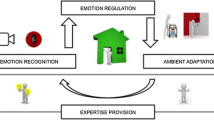Abstract
This paper introduces a project named “Improvement of the Elderly Quality of Life and Care through Smart Emotion Regulation”. The objective of the project is to find solutions for improving the quality of life and care of the elderly who can or wants to continue living at home by using emotion regulation techniques. Cameras and body sensors are used for monitoring the elderlies’ facial and gestural expression, activity and behaviour, as well as relevant physiological data. This way the older people’s emotions are inferred and recognized. Music, colour and light are the simulating means to regulate their emotions towards a positive and pleasant mood.
Access this chapter
Tax calculation will be finalised at checkout
Purchases are for personal use only
Preview
Unable to display preview. Download preview PDF.
Similar content being viewed by others
References
Chen, M., Gonzalez, S., Vasilakos, A., Cao, H., Leung, V.C.M.: Body area networks: a survey. Mobile Networks and Applications 16, 171–193 (2011)
Jovanov, E., Milenkovic, A.: Body area networks for ubiquitous healthcare applications: opportunities and challenges. Journal of Medical Systems 35, 1245–1254 (2011)
Pavón, J., Gómez-Sanz, J.J., Fernández-Caballero, A., Valencia-Jiménez, J.J.: Development of intelligent multi-sensor surveillance systems with agents. Robotics and Autonomous Systems 55, 892–903 (2008)
Gascueña, J.M., Fernández-Caballero, A.: On the use of agent technology in intelligent, multi-sensory and distributed surveillance. The Knowledge Engineering Review 26, 191–208 (2011)
Fernández-Caballero, A., Castillo, J.C., López, M.T., Serrano-Cuerda, J., Sokolova, M.V.: INT3–Horus framework for multispectrum activity interpretation in intelligent environments. Expert Systems with Applications 40, 6715–6727 (2013)
Bartholmai, M., Koeppe, E., Neumann, P.P.: Monitoring of hazardous scenarios using multi–sensor devices. In: The Fourth International Conference on Sensor Device Technologies and Applications, pp. 9–13 (2013)
Ekman, P., Friesen, W.V., Hager, J.C.: The new Facial Action Coding System (2002)
Soleymani, M., Lichtenauer, J., Pun, T., Pantic, M.: A multi–modal affective database for affect recognition and implicit tagging. IEEE Transactions on Affective Computing 3, 42–55 (2012)
Medjahed, H., Istrate, D., Boudy, J., Baldinger, J.-L.: A pervasive multi-sensor data fusion for smart home healthcare monitoring. In: IEEE International Conference in Fuzzy Systems, pp. 1466–1473 (2011)
Serrano, J.P., Latorre, J.M., Montanes, J.: Life review therapy using autobiographical retrieval practice for older adults with depressive symptomatology. Psychology and Aging 19, 272–277 (2004)
Kim, J., André, E.: Emotion recognition based on physiological changes in music listening. IEEE Transactions on Pattern Analysis and Machine Intelligence 30, 2067–2083 (2008)
Schachter, S., Singer, J.E.: Cognitive, social and physiological determinants of emotional state. Psychological Review 69, 379–399 (1962)
Velten, E.: A laboratory task for induction of mood states. Behaviour Research and Therapy 6, 473–482 (1968)
Niedenthal, P.M., Halberstadt, J.B., Setterlund, M.C.: Being happy and seing happy: Emotional state mediates visual word recognition. Cognition & Emotion 11, 403–432 (1997)
Gross, J.J., Levenson, R.W.: Emotion ilicitation using films. Cognition & Emotion 9, 87–108 (1995)
Brewer, D., Doughtie, E.B.: Induction of mood and mood shift. Journal of Clinical Psychology 36, 215–226 (1980)
Bower, G.H.: Mood and memory. American Psychologist 36, 129–148 (1981)
Livingstone, S.R., Palmer, C., Schubert, E.: Emotion response to musical repetition. Emotion 12, 552–567 (2012)
Livingstone, R.S., Thompson, W.F.: The emergence of music from the theory of mind. Musicae Scientiae 17, 83–115 (2009)
Acampora, G., Vitiello, A.: Interoperable neuro–fuzzy services for emotion–aware ambient intelligence. Neurocomputing 122, 3–12 (2013)
Susskind, J.M., Littlewort, G., Bartlett, M.S., Movellan, J., Anderson, A.K.: Human and computer recognition of facial expressions of emotion. Neuropsychologia 45, 152–162 (2007)
Vogt, T., André, E., Wagner, J.: Automatic recognition of emotions from speech: A review of the literature and recommendations for practical realisation. In: Peter, C., Beale, R. (eds.) Affect and Emotion in HCI. LNCS, vol. 4868, pp. 75–91. Springer, Heidelberg (2008)
Silva, P.R.D., Osano, M., Marasinghe, A., Madurapperuma, A.P.: Towards recognizing emotion with affective dimensions through body gestures. In: Seventh IEEE International Conference on Automatic Face and Gesture Recognition, pp. 269–274 (2006)
Author information
Authors and Affiliations
Editor information
Editors and Affiliations
Rights and permissions
Copyright information
© 2014 Springer International Publishing Switzerland
About this paper
Cite this paper
Fernández-Caballero, A., Latorre, J.M., Pastor, J.M., Fernández-Sotos, A. (2014). Improvement of the Elderly Quality of Life and Care through Smart Emotion Regulation. In: Pecchia, L., Chen, L.L., Nugent, C., Bravo, J. (eds) Ambient Assisted Living and Daily Activities. IWAAL 2014. Lecture Notes in Computer Science, vol 8868. Springer, Cham. https://doi.org/10.1007/978-3-319-13105-4_50
Download citation
DOI: https://doi.org/10.1007/978-3-319-13105-4_50
Publisher Name: Springer, Cham
Print ISBN: 978-3-319-13104-7
Online ISBN: 978-3-319-13105-4
eBook Packages: Computer ScienceComputer Science (R0)




